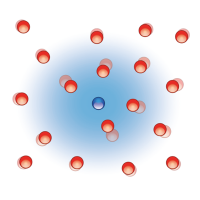News
Bose polarons meet their fate at quantum criticality
An electron moving through the crystal lattice of a solid slightly attracts the ions on its path. The electron and the crystal deformations move together a “quasi-particle”, heavier than the bare electron – the so-called polaron. Such quasi-particles form the basis of descriptions of many solids. However, in modern materials, such as the high-temperature superconducting cuprates, electron interactions and correlations between them are so strong that the quasi-particle picture fails to explain their properties. Despite tremendous effort over the past decades, our understanding of the underlying mechanism that gives rise to high-temperature superconductivity is still limited, as is our knowledge of why these materials feature so-called “strange metals”, where seemingly no quasiparticles exist.
In work reported in Science, Researchers at MIT, led by Prof. Martin Zwierlein, have studied the fate of polaronic quasi-particles in the approach towards strong interactions. For this, fermionic atoms, carrying half-integer spin, were used as stand-ins for elecrons, and immersed in a Bose-Einstein condensate as the host material. This realized a pristine model system where interactions between the impurity and the host bath were freely tunable. Strikingly, for strong interactions the impurities started to scatter as strongly as known for electrons in the “strange metal” phase of the cuprates, with a scattering rate given by Planck’s constant and the bath’s temperature. As the temperature increased, the impurities lost their polaronic character progressively, as scattering became as rapid as allowed by the laws of quantum mechanics. The “Planckian” scattering and the loss of quasi-particle character are hallmarks of so-called quantum critical behavior near quantum phase transitions, which are transitions that occur even at zero temperature. The fermions immersed in a Bose gas realized by the MIT group appear to be an ideal realization of this quantum critical scenario, and may shed light on the workings of the high-temperature cuprates.
Zwierlein’s team members include physics graduate students Zoe Yan, Yiqi Ni, and postdoc Carsten Robens, all of whom are associated with MIT’s Center for Ultracold Atoms and the Research Laboratory of Electronics.
This work was funded by the National Science Foundation, the Air Force Office of Scientific Research, the Army Research Office, the David and Lucile Packard Foundation, and the Gordon and Betty Moore Foundation.
